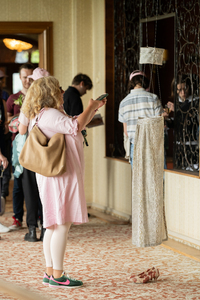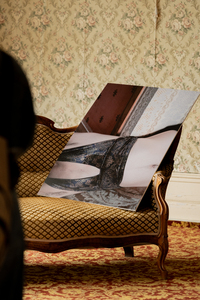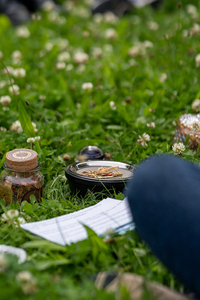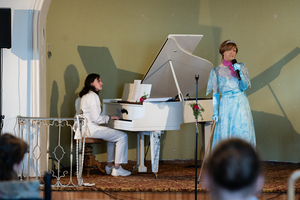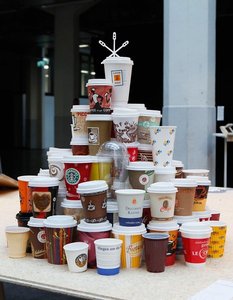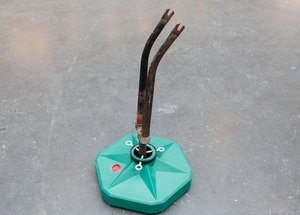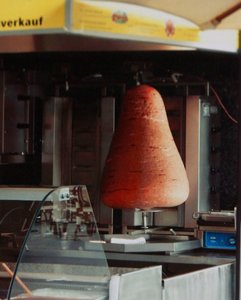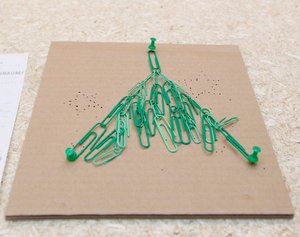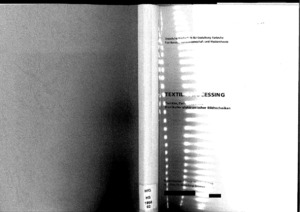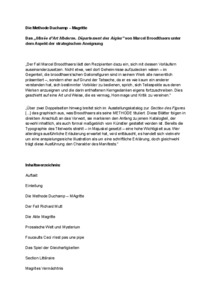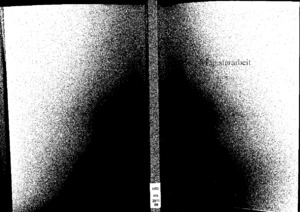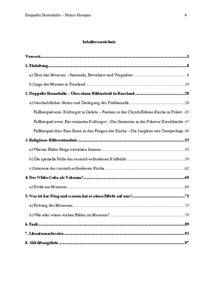"Alle Rechte vorbehalten"
| Begriff | Alle Rechte vorbehalten |
| Metakey | Rechtsschutz/Lizenz (rights:licence) |
| Typ | Keyword |
| Vokabular | Rechte |
1202 Inhalte
- Seite 1 von 101
Ghosts of Grand Hotels
- Titel
- Ghosts of Grand Hotels
- Autor/in
- Beschreibung (de)
- Geister von Grand Hotels
Willkommen im Grand Hotel, liebe Passagiere! Das Reisebüro Ghostly Matters bietet Ihnen eine saisonale Fahrt durch die weite, unheilvolle Landschaft des Schwarzwalds mitten in das Herz eines ehemaligen Grandhotels: Waldlust. Seine offenen Türen verbreiten den einzigartigen Duft von Urlaub, Klassizismus, Kunst und Luxus. Entdecken Sie mit uns die unerzählten Erzählungen seiner Wände, Möbel, Küche, Mitarbeiter und Gäste, die das Internationale mit dem Lokalen verbinden. Welche Spuren hinterlassen sich nach dem Verlassen der Zimmer im Hotel? Unser Team empfängt Sie am 5. Juli in Freudenstadt zu einem außergewöhnlichen Besuch der Ausstellungsstätte Waldlust. Die kommende Ausstellung ist die Fortsetzung einer kritischen und spielerischen Auseinandersetzung mit dem Erbe und dem zeitgenössischen Status von Grand Hotels. Welche Geister verfolgen uns in den Räumen des klassizistischen und kolonialen Luxus, in den Kammern der Fürsorge und Gastfreundschaft und in den Treffpunkten von Künstlern und wohlhabendem Bürgertum? Welche Zukünfte könnten aus einem Pool verschiedener Zeitlichkeiten entstehen? Die Ausstellung ist eine Kooperation zwischen Waldlust e.V., HfG Karlsruhe, ABK Stuttgart und Hochschule Offenburg.
- Geister von Grand Hotels
- Beschreibung (en)
- Ghosts of Grand Hotels
Welcome to Grand Hotel, dear passengers! The travel agency Ghostly Matters offers you a seasonal ride through the vast, ominous landscape of the Black Forest right into the heart of a former Grand Hotel: Waldlust. Its open doors are spreading the unique odor of holidays, classism, art and luxury. Discover with us the untold narratives of its walls, furniture, kitchen, employees and guests, that merged the international and the local. Which traces are inscribed in the hotel after the rooms are left? Our Team will welcome you on the 5th of July in Freudenstadt for a remarkable visit to the exhibition setting at Waldlust. The upcoming exhibition is the continuation of a critical and playful exploration on the legacy and contemporary status of grand hotels. Which ghosts are haunting us in the spaces of classicist and colonial luxury, the chambers of care work and hospitality and meeting places of artists and wealthy bourgeoisie? Which futures could emerge out of a pool combining various temporalities? The exhibition is a collaboration between Waldlust e.V., HfG Karlsruhe, ABK Stuttgart and Hochschule Offenburg.
- Ghosts of Grand Hotels
- Kategorie
- Typ des Projekts/Werks
- Datierung
- 25.04.2024 - 31.07.2024
- Mitwirkende
- Ort: Institution
- Ort
- Hotel Waldlust, Freudenstadt
- Stadt
- Land
- Beteiligte Institution(en)
- Titel
- Ghosts of Grand Hotels
- Titel (en)
- Ghosts of Grand Hotels
- Urheberrechtshinweis
- © Staatliche Hochschule für Gestaltung Karlsruhe, Foto: Matylda Eaton
- Rechtsschutz/Lizenz
- Freigabe Nutzung HfG
- Medienersteller/in
- Abgebildete Personen
- Projektleiter/in
- Semester
- Studiengang
- Lehrveranstaltung
- Importiert am
- 22.08.2024
- Übergeordnete Sets
- 1
Ghosts of Grand Hotels
- Titel
- Ghosts of Grand Hotels
- Autor/in
- Beschreibung (de)
- Geister von Grand Hotels
Willkommen im Grand Hotel, liebe Passagiere! Das Reisebüro Ghostly Matters bietet Ihnen eine saisonale Fahrt durch die weite, unheilvolle Landschaft des Schwarzwalds mitten in das Herz eines ehemaligen Grandhotels: Waldlust. Seine offenen Türen verbreiten den einzigartigen Duft von Urlaub, Klassizismus, Kunst und Luxus. Entdecken Sie mit uns die unerzählten Erzählungen seiner Wände, Möbel, Küche, Mitarbeiter und Gäste, die das Internationale mit dem Lokalen verbinden. Welche Spuren hinterlassen sich nach dem Verlassen der Zimmer im Hotel? Unser Team empfängt Sie am 5. Juli in Freudenstadt zu einem außergewöhnlichen Besuch der Ausstellungsstätte Waldlust. Die kommende Ausstellung ist die Fortsetzung einer kritischen und spielerischen Auseinandersetzung mit dem Erbe und dem zeitgenössischen Status von Grand Hotels. Welche Geister verfolgen uns in den Räumen des klassizistischen und kolonialen Luxus, in den Kammern der Fürsorge und Gastfreundschaft und in den Treffpunkten von Künstlern und wohlhabendem Bürgertum? Welche Zukünfte könnten aus einem Pool verschiedener Zeitlichkeiten entstehen? Die Ausstellung ist eine Kooperation zwischen Waldlust e.V., HfG Karlsruhe, ABK Stuttgart und Hochschule Offenburg.
- Geister von Grand Hotels
- Beschreibung (en)
- Ghosts of Grand Hotels
Welcome to Grand Hotel, dear passengers! The travel agency Ghostly Matters offers you a seasonal ride through the vast, ominous landscape of the Black Forest right into the heart of a former Grand Hotel: Waldlust. Its open doors are spreading the unique odor of holidays, classism, art and luxury. Discover with us the untold narratives of its walls, furniture, kitchen, employees and guests, that merged the international and the local. Which traces are inscribed in the hotel after the rooms are left? Our Team will welcome you on the 5th of July in Freudenstadt for a remarkable visit to the exhibition setting at Waldlust. The upcoming exhibition is the continuation of a critical and playful exploration on the legacy and contemporary status of grand hotels. Which ghosts are haunting us in the spaces of classicist and colonial luxury, the chambers of care work and hospitality and meeting places of artists and wealthy bourgeoisie? Which futures could emerge out of a pool combining various temporalities? The exhibition is a collaboration between Waldlust e.V., HfG Karlsruhe, ABK Stuttgart and Hochschule Offenburg.
- Ghosts of Grand Hotels
- Kategorie
- Typ des Projekts/Werks
- Datierung
- 25.04.2024 - 31.07.2024
- Mitwirkende
- Ort: Institution
- Ort
- Hotel Waldlust, Freudenstadt
- Stadt
- Land
- Beteiligte Institution(en)
- Titel
- Ghosts of Grand Hotels
- Titel (en)
- Ghosts of Grand Hotels
- Urheberrechtshinweis
- © Staatliche Hochschule für Gestaltung Karlsruhe, Foto: Matylda Eaton
- Rechtsschutz/Lizenz
- Freigabe Nutzung HfG
- Medienersteller/in
- Abgebildete Personen
- Projektleiter/in
- Semester
- Studiengang
- Lehrveranstaltung
- Importiert am
- 22.08.2024
- Übergeordnete Sets
- 1
Ghosts of Grand Hotels
- Titel
- Ghosts of Grand Hotels
- Autor/in
- Beschreibung (de)
- Geister von Grand Hotels
Willkommen im Grand Hotel, liebe Passagiere! Das Reisebüro Ghostly Matters bietet Ihnen eine saisonale Fahrt durch die weite, unheilvolle Landschaft des Schwarzwalds mitten in das Herz eines ehemaligen Grandhotels: Waldlust. Seine offenen Türen verbreiten den einzigartigen Duft von Urlaub, Klassizismus, Kunst und Luxus. Entdecken Sie mit uns die unerzählten Erzählungen seiner Wände, Möbel, Küche, Mitarbeiter und Gäste, die das Internationale mit dem Lokalen verbinden. Welche Spuren hinterlassen sich nach dem Verlassen der Zimmer im Hotel? Unser Team empfängt Sie am 5. Juli in Freudenstadt zu einem außergewöhnlichen Besuch der Ausstellungsstätte Waldlust. Die kommende Ausstellung ist die Fortsetzung einer kritischen und spielerischen Auseinandersetzung mit dem Erbe und dem zeitgenössischen Status von Grand Hotels. Welche Geister verfolgen uns in den Räumen des klassizistischen und kolonialen Luxus, in den Kammern der Fürsorge und Gastfreundschaft und in den Treffpunkten von Künstlern und wohlhabendem Bürgertum? Welche Zukünfte könnten aus einem Pool verschiedener Zeitlichkeiten entstehen? Die Ausstellung ist eine Kooperation zwischen Waldlust e.V., HfG Karlsruhe, ABK Stuttgart und Hochschule Offenburg.
- Geister von Grand Hotels
- Beschreibung (en)
- Ghosts of Grand Hotels
Welcome to Grand Hotel, dear passengers! The travel agency Ghostly Matters offers you a seasonal ride through the vast, ominous landscape of the Black Forest right into the heart of a former Grand Hotel: Waldlust. Its open doors are spreading the unique odor of holidays, classism, art and luxury. Discover with us the untold narratives of its walls, furniture, kitchen, employees and guests, that merged the international and the local. Which traces are inscribed in the hotel after the rooms are left? Our Team will welcome you on the 5th of July in Freudenstadt for a remarkable visit to the exhibition setting at Waldlust. The upcoming exhibition is the continuation of a critical and playful exploration on the legacy and contemporary status of grand hotels. Which ghosts are haunting us in the spaces of classicist and colonial luxury, the chambers of care work and hospitality and meeting places of artists and wealthy bourgeoisie? Which futures could emerge out of a pool combining various temporalities? The exhibition is a collaboration between Waldlust e.V., HfG Karlsruhe, ABK Stuttgart and Hochschule Offenburg.
- Ghosts of Grand Hotels
- Kategorie
- Typ des Projekts/Werks
- Datierung
- 25.04.2024 - 31.07.2024
- Mitwirkende
- Ort: Institution
- Ort
- Hotel Waldlust, Freudenstadt
- Stadt
- Land
- Beteiligte Institution(en)
- Titel
- Ghosts of Grand Hotels
- Titel (en)
- Ghosts of Grand Hotels
- Urheberrechtshinweis
- © Staatliche Hochschule für Gestaltung Karlsruhe, Foto: Matylda Eaton
- Rechtsschutz/Lizenz
- Freigabe Nutzung HfG
- Medienersteller/in
- Abgebildete Personen
- Projektleiter/in
- Semester
- Studiengang
- Lehrveranstaltung
- Importiert am
- 22.08.2024
- Übergeordnete Sets
- 1
Ghosts of Grand Hotels
- Titel
- Ghosts of Grand Hotels
- Autor/in
- Beschreibung (de)
- Geister von Grand Hotels
Willkommen im Grand Hotel, liebe Passagiere! Das Reisebüro Ghostly Matters bietet Ihnen eine saisonale Fahrt durch die weite, unheilvolle Landschaft des Schwarzwalds mitten in das Herz eines ehemaligen Grandhotels: Waldlust. Seine offenen Türen verbreiten den einzigartigen Duft von Urlaub, Klassizismus, Kunst und Luxus. Entdecken Sie mit uns die unerzählten Erzählungen seiner Wände, Möbel, Küche, Mitarbeiter und Gäste, die das Internationale mit dem Lokalen verbinden. Welche Spuren hinterlassen sich nach dem Verlassen der Zimmer im Hotel? Unser Team empfängt Sie am 5. Juli in Freudenstadt zu einem außergewöhnlichen Besuch der Ausstellungsstätte Waldlust. Die kommende Ausstellung ist die Fortsetzung einer kritischen und spielerischen Auseinandersetzung mit dem Erbe und dem zeitgenössischen Status von Grand Hotels. Welche Geister verfolgen uns in den Räumen des klassizistischen und kolonialen Luxus, in den Kammern der Fürsorge und Gastfreundschaft und in den Treffpunkten von Künstlern und wohlhabendem Bürgertum? Welche Zukünfte könnten aus einem Pool verschiedener Zeitlichkeiten entstehen? Die Ausstellung ist eine Kooperation zwischen Waldlust e.V., HfG Karlsruhe, ABK Stuttgart und Hochschule Offenburg.
- Geister von Grand Hotels
- Beschreibung (en)
- Ghosts of Grand Hotels
Welcome to Grand Hotel, dear passengers! The travel agency Ghostly Matters offers you a seasonal ride through the vast, ominous landscape of the Black Forest right into the heart of a former Grand Hotel: Waldlust. Its open doors are spreading the unique odor of holidays, classism, art and luxury. Discover with us the untold narratives of its walls, furniture, kitchen, employees and guests, that merged the international and the local. Which traces are inscribed in the hotel after the rooms are left? Our Team will welcome you on the 5th of July in Freudenstadt for a remarkable visit to the exhibition setting at Waldlust. The upcoming exhibition is the continuation of a critical and playful exploration on the legacy and contemporary status of grand hotels. Which ghosts are haunting us in the spaces of classicist and colonial luxury, the chambers of care work and hospitality and meeting places of artists and wealthy bourgeoisie? Which futures could emerge out of a pool combining various temporalities? The exhibition is a collaboration between Waldlust e.V., HfG Karlsruhe, ABK Stuttgart and Hochschule Offenburg.
- Ghosts of Grand Hotels
- Kategorie
- Typ des Projekts/Werks
- Datierung
- 25.04.2024 - 31.07.2024
- Mitwirkende
- Ort: Institution
- Ort
- Hotel Waldlust, Freudenstadt
- Stadt
- Land
- Beteiligte Institution(en)
- Titel
- Ghosts of Grand Hotels
- Titel (en)
- Ghosts of Grand Hotels
- Urheberrechtshinweis
- © Staatliche Hochschule für Gestaltung Karlsruhe, Foto: Matylda Eaton
- Rechtsschutz/Lizenz
- Freigabe Nutzung HfG
- Medienersteller/in
- Abgebildete Personen
- Projektleiter/in
- Semester
- Studiengang
- Lehrveranstaltung
- Importiert am
- 22.08.2024
- Übergeordnete Sets
- 1
Christmas to go
- Titel
- Christmas to go
- Titel (en)
- Oh Tannenbaum!
- Autor/in
- Typ des Projekts/Werks
- Schlagworte
- Datierung
- 2009
- Ort: Institution
- Stadt
- Land
- Beteiligte Institution(en)
- Internetlinks
- Titel
- Christmas to go
- Urheberrechtshinweis
- Evi Künstle / Hochschule für Gestaltung Karlsruhe
- Rechtsschutz/Lizenz
- Medienersteller/in
- Semester
- Importiert am
- 17.12.2018
- Übergeordnete Sets
- 1
Rodolphe
- Titel
- Rodolphe
- Titel (en)
- Oh Tannenbaum!
- Autor/in
- Typ des Projekts/Werks
- Schlagworte
- Datierung
- 2009
- Ort: Institution
- Stadt
- Land
- Beteiligte Institution(en)
- Internetlinks
- Titel
- Rodolphe
- Urheberrechtshinweis
- Evi Künstle / Hochschule für Gestaltung Karlsruhe
- Rechtsschutz/Lizenz
- Medienersteller/in
- Semester
- Importiert am
- 17.12.2018
- Übergeordnete Sets
- 1
Dönerbaum
- Titel
- Dönerbaum
- Titel (en)
- Oh Tannenbaum!
- Autor/in
- Typ des Projekts/Werks
- Schlagworte
- Datierung
- 2009
- Ort: Institution
- Stadt
- Land
- Beteiligte Institution(en)
- Internetlinks
- Titel
- Dönerbaum
- Urheberrechtshinweis
- Evi Künstle / Hochschule für Gestaltung Karlsruhe
- Rechtsschutz/Lizenz
- Medienersteller/in
- Semester
- Importiert am
- 17.12.2018
- Übergeordnete Sets
- 1
Bürobaum
- Titel
- Bürobaum
- Titel (en)
- Oh Tannenbaum!
- Autor/in
- Typ des Projekts/Werks
- Schlagworte
- Datierung
- 2009
- Ort: Institution
- Stadt
- Land
- Beteiligte Institution(en)
- Internetlinks
- Titel
- Bürobaum
- Urheberrechtshinweis
- Evi Künstle / Hochschule für Gestaltung Karlsruhe
- Rechtsschutz/Lizenz
- Medienersteller/in
- Semester
- Importiert am
- 17.12.2018
- Übergeordnete Sets
- 1
Textile Provessing Deckblatt
- Titel
- Textile Provessing Deckblatt
- Schlagworte
- Datierung
- 02.11.1998
- Titel
- Textile Provessing Deckblatt
- Urheberrechtshinweis
- Birgit Schneider
- Rechtsschutz/Lizenz
- Medienersteller/in
- Beziehung/Funktion
- Importiert am
- 09.01.2025
- Übergeordnete Sets
- 1
Die Methode Duchamp – Magritte Abstract / Inhaltsv.
- Titel
- Die Methode Duchamp – Magritte Abstract / Inhaltsv.
- Untertitel
- Das „Musée d’Art Moderne. Département des Aigles” von Marcel Broodthaers unter dem Aspekt der strategischen Aneignung
- Autor/in
- Beschreibung (de)
- „Der Fall Marcel Broodthaers lädt den Rezipienten dazu ein, sich mit dessen Vorläufern auseinanderzusetzen. Nicht etwa, weil dort Geheimnisse aufzudecken wären – im Gegenteil, die broodthaers’schen Galionsfiguren sind in seinem Werk alle namentlich präsentiert –, sondern eher auf Grund der Tatsache, da er es wie kaum ein anderer verstanden hat, sich bestimmter Vorbilder zu bedienen, sprich, sich Teilaspekte aus deren Werken anzueignen und die darin enthaltenen Kerngedanken eigens fortzuschreiben. Dies geschieht auf eine Art und Weise, die es vermag, Hommage und Kritik zu vereinen.”
„Über zwei Doppelseiten hinweg breitet sich im Ausstellungskatalog zur Section des Figures [...] das graphisch aus, was Broodthaers als seine METHODE tituliert. Diese Blätter folgen in direktem Anschluß an das Vorwort, sie markieren den Anfang zu jenem Katalogteil, der sowohl inhaltlich, als auch formal maßgeblich vom Künstler gestaltet worden ist. Bereits die Typographie des Titelworts strahlt – in Majuskel gesetzt – eine hohe Wichtigkeit aus. Wer allerdings ausführliche Erläuterung erwartet hat, wird enttäuscht, es handelt sich vielmehr um eine anspielungsreiche Illustration als um eine schriftliche Erklärung, doch gleichwohl trägt diese Ausführung den Charakter des Manifests.”
- „Der Fall Marcel Broodthaers lädt den Rezipienten dazu ein, sich mit dessen Vorläufern auseinanderzusetzen. Nicht etwa, weil dort Geheimnisse aufzudecken wären – im Gegenteil, die broodthaers’schen Galionsfiguren sind in seinem Werk alle namentlich präsentiert –, sondern eher auf Grund der Tatsache, da er es wie kaum ein anderer verstanden hat, sich bestimmter Vorbilder zu bedienen, sprich, sich Teilaspekte aus deren Werken anzueignen und die darin enthaltenen Kerngedanken eigens fortzuschreiben. Dies geschieht auf eine Art und Weise, die es vermag, Hommage und Kritik zu vereinen.”
- Beschreibung (en)
- ‘The case of Marcel Broodthaers invites the recipient to engage with his precursors. Not because there are secrets to be uncovered there - on the contrary, Broodthaers' figureheads are all presented by name in his work - but rather due to the fact that he understood better than almost anyone else how to make use of certain role models, i.e. to appropriate partial aspects from their works and to continue the core ideas contained therein in his own way. This is done in a way that manages to combine homage and criticism.’
‘Over two double-page spreads in the exhibition catalogue for Section des Figures [...] Broodthaers' METHOD is presented graphically. These pages follow directly after the preface and mark the beginning of the section of the catalogue that was designed by the artist both in terms of content and form. Even the typography of the title word - set in majuscule - radiates great importance. However, anyone expecting a detailed explanation will be disappointed; it is more of an allusive illustration than a written explanation, but this version nevertheless has the character of a manifesto.’
- ‘The case of Marcel Broodthaers invites the recipient to engage with his precursors. Not because there are secrets to be uncovered there - on the contrary, Broodthaers' figureheads are all presented by name in his work - but rather due to the fact that he understood better than almost anyone else how to make use of certain role models, i.e. to appropriate partial aspects from their works and to continue the core ideas contained therein in his own way. This is done in a way that manages to combine homage and criticism.’
- Kategorie
- Datierung
- November 2010
- Sprache
- Ort: Institution
- Titel
- Die Methode Duchamp – Magritte Abstract / Inhaltsv.
- Urheberrechtshinweis
- Alice Wilke
- Rechtsschutz/Lizenz
- Freigabe Nutzung HfG
- Medienersteller/in
- Beziehung/Funktion
- Projektleiter/in
- Semester
- Studiengang
- Typ der Abschlussarbeit
- Archiv-Signatur
- HfG HS 2010 09
- Externes Archiv
- Importiert am
- 10.01.2025
- Übergeordnete Sets
- 1
Die Methode Duchamp - Magritte Deckblatt
- Titel
- Die Methode Duchamp - Magritte Deckblatt
- Untertitel
- Das „Musée d’Art Moderne. Département des Aigles” von Marcel Broodthaers unter dem Aspekt der strategischen Aneignung
- Autor/in
- Beschreibung (de)
- „Der Fall Marcel Broodthaers lädt den Rezipienten dazu ein, sich mit dessen Vorläufern auseinanderzusetzen. Nicht etwa, weil dort Geheimnisse aufzudecken wären – im Gegenteil, die broodthaers’schen Galionsfiguren sind in seinem Werk alle namentlich präsentiert –, sondern eher auf Grund der Tatsache, da er es wie kaum ein anderer verstanden hat, sich bestimmter Vorbilder zu bedienen, sprich, sich Teilaspekte aus deren Werken anzueignen und die darin enthaltenen Kerngedanken eigens fortzuschreiben. Dies geschieht auf eine Art und Weise, die es vermag, Hommage und Kritik zu vereinen.”
„Über zwei Doppelseiten hinweg breitet sich im Ausstellungskatalog zur Section des Figures [...] das graphisch aus, was Broodthaers als seine METHODE tituliert. Diese Blätter folgen in direktem Anschluß an das Vorwort, sie markieren den Anfang zu jenem Katalogteil, der sowohl inhaltlich, als auch formal maßgeblich vom Künstler gestaltet worden ist. Bereits die Typographie des Titelworts strahlt – in Majuskel gesetzt – eine hohe Wichtigkeit aus. Wer allerdings ausführliche Erläuterung erwartet hat, wird enttäuscht, es handelt sich vielmehr um eine anspielungsreiche Illustration als um eine schriftliche Erklärung, doch gleichwohl trägt diese Ausführung den Charakter des Manifests.”
- „Der Fall Marcel Broodthaers lädt den Rezipienten dazu ein, sich mit dessen Vorläufern auseinanderzusetzen. Nicht etwa, weil dort Geheimnisse aufzudecken wären – im Gegenteil, die broodthaers’schen Galionsfiguren sind in seinem Werk alle namentlich präsentiert –, sondern eher auf Grund der Tatsache, da er es wie kaum ein anderer verstanden hat, sich bestimmter Vorbilder zu bedienen, sprich, sich Teilaspekte aus deren Werken anzueignen und die darin enthaltenen Kerngedanken eigens fortzuschreiben. Dies geschieht auf eine Art und Weise, die es vermag, Hommage und Kritik zu vereinen.”
- Beschreibung (en)
- ‘The case of Marcel Broodthaers invites the recipient to engage with his precursors. Not because there are secrets to be uncovered there - on the contrary, Broodthaers' figureheads are all presented by name in his work - but rather due to the fact that he understood better than almost anyone else how to make use of certain role models, i.e. to appropriate partial aspects from their works and to continue the core ideas contained therein in his own way. This is done in a way that manages to combine homage and criticism.’
‘Over two double-page spreads in the exhibition catalogue for Section des Figures [...] Broodthaers' METHOD is presented graphically. These pages follow directly after the preface and mark the beginning of the section of the catalogue that was designed by the artist both in terms of content and form. Even the typography of the title word - set in majuscule - radiates great importance. However, anyone expecting a detailed explanation will be disappointed; it is more of an allusive illustration than a written explanation, but this version nevertheless has the character of a manifesto.’
- ‘The case of Marcel Broodthaers invites the recipient to engage with his precursors. Not because there are secrets to be uncovered there - on the contrary, Broodthaers' figureheads are all presented by name in his work - but rather due to the fact that he understood better than almost anyone else how to make use of certain role models, i.e. to appropriate partial aspects from their works and to continue the core ideas contained therein in his own way. This is done in a way that manages to combine homage and criticism.’
- Kategorie
- Datierung
- November 2010
- Sprache
- Ort: Institution
- Titel
- Die Methode Duchamp - Magritte Deckblatt
- Urheberrechtshinweis
- Alice Wilke
- Rechtsschutz/Lizenz
- Freigabe Nutzung HfG
- Medienersteller/in
- Projektleiter/in
- Semester
- Studiengang
- Typ der Abschlussarbeit
- Archiv-Signatur
- HfG HS 2010 09
- Externes Archiv
- Importiert am
- 10.01.2025
- Übergeordnete Sets
- 1
Doppelte Ikonodulie Inhaltsverzeichnis
- Titel
- Doppelte Ikonodulie Inhaltsverzeichnis
- Autor/in
- Beschreibung (de)
- „Diese Arbeit beschäftigt sich mit dem scheinbaren Widerspruch zwischen musealer und religiöser Bildbetrachtung und der Frage, welche Kriterien diesen zu Grunde liegen. Ausgangspunkt für diese Fragestellung stellt eine Debatte dar, die in Russland geführt wird. Dort wurden sämtliche Kirchen nach der Oktoberrevolution 1917 enteignet. Der Besitz ging an den Staat über, was zur Folge hatte, dass viele der ursprünglich sakralen Objekte und Bauten zerstört, umgenutzt oder an Museen übergeben wurden. Nach dem Ende des Kommunismus in Russland wurde die Frage nach der Rückgabe dieser Besitztümer häufig gestellt. Aber erst 2007 kam es zu konkreten Planungen zu einem Gesetz zur „Übergabe des in staatlichem oder städtischem Besitz befindlichen Eigentums religiöser Zweckbestimmung an die religiösen Organisationen“ von Seiten des Staates. Dieses Gesetz sollte den Kirchen des Landes eine rechtliche Grundlage für Restitutionsforderungen bieten. Zeitgleich fühlen sich russische Museen durch das Gesetz in ihrem Bestand und in ihrer Existenz bedroht.”
„Die Frage, wem man in einer solchen Auseinandersetzung Recht geben sollte, ist durchaus
schwierig: den Museen, die Kulturgüter (wie Ikonen) schützen, oder den Kirchen, für die
Bilder Instrumentarien darstellen, die eine aktive Rolle im kirchlichen Ritus spielen und auch
genau für diesen Zweck hergestellt wurden? Es geht also um die Frage, ob man sakrale
Objekte, Kultwerke also, als Kunstwerke behandeln darf beziehungsweise wie dies zu
rechtfertigen ist. Um diese Frage zu klären, ist es nötig den grundsätzlichen Umgang mit
Bildern beider Institutionen zu klären. Hieraus ergeben sich auch Fragestellungen für die
westlichen Museen und ihren bisherigen Gültigkeitsanspruch.”
- „Diese Arbeit beschäftigt sich mit dem scheinbaren Widerspruch zwischen musealer und religiöser Bildbetrachtung und der Frage, welche Kriterien diesen zu Grunde liegen. Ausgangspunkt für diese Fragestellung stellt eine Debatte dar, die in Russland geführt wird. Dort wurden sämtliche Kirchen nach der Oktoberrevolution 1917 enteignet. Der Besitz ging an den Staat über, was zur Folge hatte, dass viele der ursprünglich sakralen Objekte und Bauten zerstört, umgenutzt oder an Museen übergeben wurden. Nach dem Ende des Kommunismus in Russland wurde die Frage nach der Rückgabe dieser Besitztümer häufig gestellt. Aber erst 2007 kam es zu konkreten Planungen zu einem Gesetz zur „Übergabe des in staatlichem oder städtischem Besitz befindlichen Eigentums religiöser Zweckbestimmung an die religiösen Organisationen“ von Seiten des Staates. Dieses Gesetz sollte den Kirchen des Landes eine rechtliche Grundlage für Restitutionsforderungen bieten. Zeitgleich fühlen sich russische Museen durch das Gesetz in ihrem Bestand und in ihrer Existenz bedroht.”
- Beschreibung (en)
- ‘This work deals with the apparent contradiction between museum and religious image viewing and the question of which criteria underlie these. The starting point for this question is a debate that is taking place in Russia. There, all churches were expropriated after the October Revolution in 1917. The property was transferred to the state, which meant that many of the originally sacred objects and buildings were destroyed, repurposed or handed over to museums. After the end of communism in Russia, the question of returning these possessions was frequently raised. However, it was not until 2007 that concrete plans were made by the state for a law on the ‘transfer of state-owned or municipally-owned religious property to religious organisations’. This law was intended to provide the country's churches with a legal basis for restitution claims. At the same time, Russian museums feel that their existence is threatened by the law.’
‘The question of who should be given the right in such a dispute is a difficult one: the museums, which protect cultural assets (such as icons), or the churches, for which images are instruments that play an active role in the church rite and were produced precisely for this purpose? The question is therefore whether sacred objects, i.e. works of worship, may be treated as works of art and how this can be justified. In order to clarify this question, it is necessary to clarify the fundamental handling of images in both institutions. This also raises questions for Western museums and their current claim to validity.’
- ‘This work deals with the apparent contradiction between museum and religious image viewing and the question of which criteria underlie these. The starting point for this question is a debate that is taking place in Russia. There, all churches were expropriated after the October Revolution in 1917. The property was transferred to the state, which meant that many of the originally sacred objects and buildings were destroyed, repurposed or handed over to museums. After the end of communism in Russia, the question of returning these possessions was frequently raised. However, it was not until 2007 that concrete plans were made by the state for a law on the ‘transfer of state-owned or municipally-owned religious property to religious organisations’. This law was intended to provide the country's churches with a legal basis for restitution claims. At the same time, Russian museums feel that their existence is threatened by the law.’
- Kategorie
- Datierung
- 17.08.2011
- Sprache
- Ort: Institution
- Titel
- Doppelte Ikonodulie Inhaltsverzeichnis
- Urheberrechtshinweis
- Marco Hompes
- Rechtsschutz/Lizenz
- Medienersteller/in
- Beziehung/Funktion
- Projektleiter/in
- Semester
- Studiengang
- Typ der Abschlussarbeit
- Archiv-Signatur
- HfG HS 2011 03
- Externes Archiv
- Importiert am
- 12.01.2025
- Übergeordnete Sets
- 1
